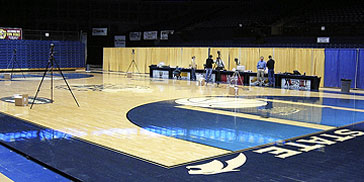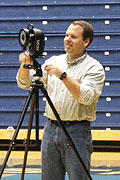by Jason Borger
This is the second report detailing the on-going Montana State University (MSU)/Fly Casting Institute (FCI) fly-casting motion-capture (mo-cap) sessions at MSU in Bozeman, Montana. During this second session, additional work was done on various aspects of casting, as well as further biomechanic/medical studies. Writer, photographer and guide Jenny Grossenbacher was also present during the session. Jenny published an article on the experience in the May 2005 issue of American Angler ("Casting into the Future").
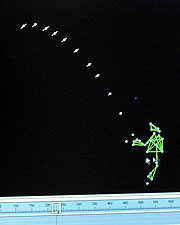 |
|
January 2005. A digitized version of my upper body plus my fly rod. |
The crew for this capture session again included Dr. Mike Hahn, Dr. Tim McCue and myself. Katie O'Keefe (MSU grad in Mech. Engineering), and graduate student Josh Allen were on-hand, as well, working with Dr. Hahn. Previous motion-capture alumni, Tyler Brown (MSU grad student) and Dr. Server Sadik (MSU-Civil Engineering), were also present for part of the two-day session. In order to begin stocking the dataset library more fully, a number of local casters--beginners to guides--were asked to cast. This additional group was not only captured, but they also received casting instruction at various points during the capture. This allowed us to track changes in each caster's stroke.
Although this session did not utilize the EMG leads employed previously (to detect muscle firing), all participants were given focused, upper-extremity physical exams (via Tim). This, combined with a detailed casting questionnaire, served to further integrate the motion data with each caster's physical history. At least one caster was surprised to discover a shoulder problem that was undiagnosed prior to the capture session.
|
|
|
(top) The "casting stage" in place on center court at MSU. Six cameras at differing heights and angles provided coverage (or "volume") for capturing the caster, the rod, and part of the line. By casting diagonally across the court, it was possible to do full line--and longer--casts. (bottom, left to right) Josh Allen setting a line of mo-cap tracking balls onto a strip of adhesive tape. Katie O'Keefe using "The Big Scissors" to cut the adhesive tape into ready-to-stick squares (each with a tracking ball in place). Mike setting up one of the six infrared cameras. |
The much larger capture stage allowed us to get some of the data that had eluded us in August of 2004. We also upped the ante in terms of rod and line by employing better reflective "flags" on both, so that more overall data could be collected and so that fewer data points would be lost due to velocity factors. With the improved capture setting and methods, we were able to get some intimate looks at the rod, line and hands during a variety of long-range and "presentation" casts.
There was a list of casts--and parts of casts--that I really wanted to see. We managed to capture a narrow majority of that list, which actually yielded more data than I had assumed it would. Once the PC crunched its way through the numbers, it displayed some aspects of casting that were not only exciting to mind, but simply beautiful to the eye. Perhaps the most engaging moments came when the time-tracking feature of the mo-cap software was turned on. This provided a look at data-point movement over a set period of time (which was fully user-adjustable). Seeing the rod and line pathways streak across the screen (or crawl on a frame-by-frame basis) made the data come alive in a way that I have never seen before. Want to know how much the tip of the rod moves in .1 sec compared to the mid-section, compared to the butt? Okay, no problem. Want to see continuous tracking of the rod tip during a cast? Want to do it from directly above the caster? No problem. Want to see whether or not you have a straight-line-pathway of the rod tip at any time during a cast? Again, no problem.
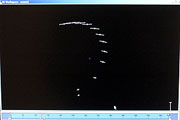 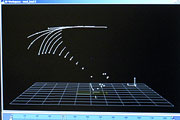 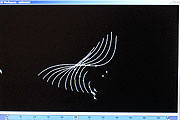 |
|
(upper left) A view from directly above my head. The dots are me, the vertical line shows the tracking of the rod and fly line through my casting stroke. By zooming in on the image (or viewing the raw dataset), one can tell just how good (or bad) tracking is for any cast. (upper right) A frame showing extreme, but controlled turn-over of the the fly rod during a maximum-distance backcast. Neither the hand/arm nor the fly line are tracked in this shot. Note that the tip of the rod is basically flattened out. The butt section of the rod is rotated almost exactly 135-degrees from horizontal (45-degrees from vertical). (lower left) A frame showing me (the cluster of dots in the lower center), the fly rod (bending down and forward) and the line (the three uppermost streaks). This image has time-tracking turned on to show the pathway of each data point on the rod and line as they move through space. The longer the streak, the more a data point has moved.(lower right) I find the end result of motion capture to be a thing of kinetic beauty. This still frame illustrates the virtual sculpture created by the time-tracked pathway of the fly rod only as it travels through a Corkscrew Curve Cast. The view is from the front of the caster. For reference, the rod in all four frames is a Sage XP 590-4. |
One of the unique aspects of this capture session involved casting with a cast — a fiberglass cast, that is. Tim wanted to take a look at back/shoulder/elbow involvement sans wrist, and I wanted to see some how the rod/line would look with a truly locked-out wrist (which a fiberglass cast can offer on a consistent basis). Tim set my wrist in my "neutral" casting position — rod horizontal, with my hand in my favored Three-Point Grip arrangement. Since the cast was fiberglass an had a multi-minute set-up time, I was able to conform it to the rod handle so that my hand was as comfortable as possible. Once the cast was set, though, I was locked in.
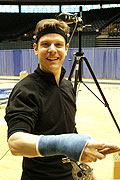 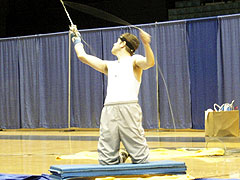 |
|
(left) Me with my wrist locked in a customized fiberglass cast. (right) Taking one of several long-distance casts with my wrist locked in place. |
The end result of the cast-on, casting mini-session (confused yet?) provided interesting feedback to both Tim and myself. Some of the results were expected, or at least not surprising, while other results were intriguing from both casting and medical perspectives.
While there was much forward movement in acquiring data and refining methods during this capture session, it is still only the beginning of things to come. There are so many questions and so many possibilities that the future of fly-casting motion capture is wide open, indeed! Watch this space for more in 2005...
Photos by Jason Borger and Dr. Tim McCue.
Copyright © Fly Casting Institute. All Rights Reserved.
![]()
